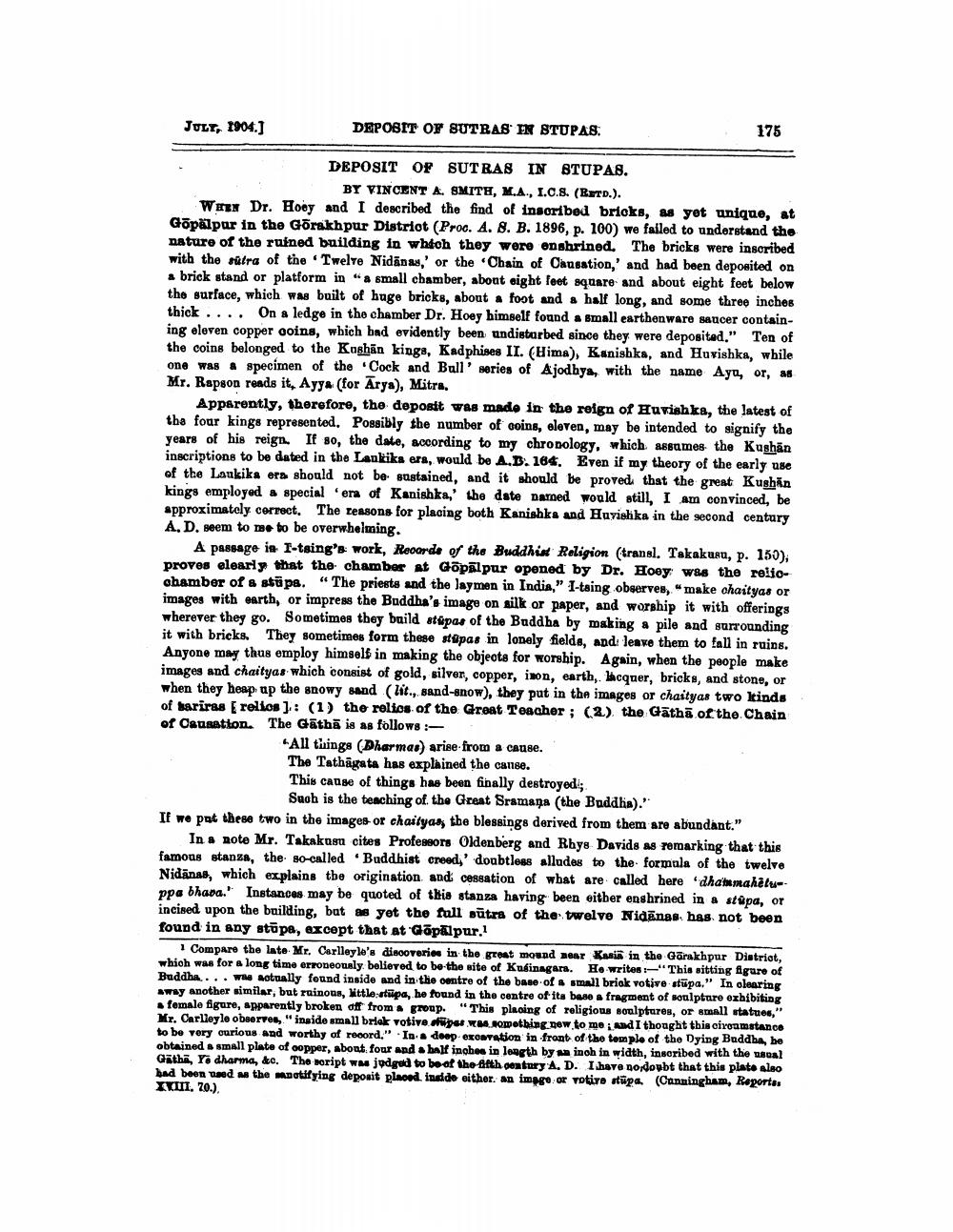________________
JULI, 1904.)
DEPOBIT OF SUTRAS IR STUPAS
175
DEPOSIT OF SUTRAS IN BTUPAS.
BY VINCENT A. SMITH, M.A., I.C.S. (Red.). WEEN Dr. Hooy and I described the find of inscribed bricks, as yet unique, at Göpalpur in the Gorakhpur Distriot (Proc. A. 8. B. 1896, p. 100) we failed to understand the nature of the ruined building in which they were enshrined. The bricks were inscribed with the sutra of the Twelve Nidānas,' or the Chain of Causation,' and had been deposited on a brick stand or platform in a small chamber, about eight feet square and about eight feet below the surface, which was built of huge bricks, about a foot and a half long, and some three inches thick .... On a ledge in the chamber Dr. Hoey himself found a small earthenware saucer containing eleven copper coins, which had evidently been undistarbed since they were deposited." Ten of the coins belonged to the Kushān kings, Kadphises II. (Hima), Kanishka, and Huvishka, while one was a specimen of the Cock and Ball' series of Ajodhys, with the name Ays, or, as Mr. Rapson reads it, Ayya (for Arys), Mitra.
Apparently, therefore, the deposit was made in the reign of Huvishka, the latest of the four kings represented. Possibly the number of coins, eleven, may be intended to signify the years of his reign. If so, the date, according to my chronology, which assumes the Kushän inscriptions to be dated in the Lankiks ers, would be A.B. 164. Even if my theory of the early use of the Laukiks ers should not be sustained, and it should be proved that the great Kushin kings employed a special era of Kanishka,' the date Damned would still, I am convinced, be approximately cerrect. The reasons for placing both Kanishka and Hayishka in the second century A, D. seem to me to be overwhelming.
A passage ia I-tsing's work, Records of the Buddhist Religion (transl. Takakusa, p. 150); proves elearly that the chamber at Gopalpur opened by Dr. Hoey was the reliochamber of a stūpe. “The priests and the Jaymen in India," I-tsing observes, make chaityas or images with earth, or impress the Buddha's image on silk or paper, and worship it with offerings wherever they go. Sometimes they build støpas of the Buddha by making a pile and surrounding it with bricks. They sometimes form these stupas in lonely fields, and leave them to fall in ruins. Anyone may thus employ himself in making the objects for worship. Again, when the people make images and chaityas which consist of gold, silver, copper, inon, earth, lacquer, bricks, and stone, or when they heap up the snowy sand (lit., sand-snow), they put in the images or chaityas two kinds of kariras rellos): (1) the relies of the Great Teacher ; (2) the Gathā of the Chain of Catisation. The Gathā is as follows :
All things (Dharmas) arise from a cause. The Tathāgata has explained the canse. This cause of things has been finally destroyed;
Suoh is the teaching of the Great Sramana (the Buddha)." If we put these two in the images or chaityas, the blessings derived from them are abundant."
In a note Mr. Takakusu cites Professors Oldenberg and Rhys Davids as remarking that this famous stanza, the so-called Buddhist creed,' doubtless alludes to the formula of the twelve Nidänas, which explains the origination and cessation of what are called here "dhatmahelyppa bhapa." Instances may be quoted of this stanza having been either enshrined in a stúpa, or incised upon the building, but as yet the full sūtra of the twelve Nidānas. has not been found in any stôpa, except that at Gāpilpur.
1 Compare the late Mr. Carlleylo's dincoveries in the great mound near Kasis in the Gārakhpur District, which was for a long time erroneously believed to be the site of Kusinagars. He writes:-"This sitting figure of Buddha... We actually found inside and in the centre of the base of a small brick votive stupa." In clearing away another similar, but ruinous, Mittle tips, he found in the centre of its besos fragment of soulpture e
female figure, apparently broken off from a group. "This placing of religious soulptures, or small statues," Kr. Carlleyle observes," inside small brlok votive sipas something new to me and I thought this circumstance to be very curious and worthy of record." In a deop-exentation in front of the temple of the Dying Buddha, be obtained a small plate of copper, about four and a half inghes in length by inoh in width, inscribed with the usual Githa, Yo dharma, &c. The pript was judged to boot the fifth pontury A. D. I have no doubt that this platoslao had been wed na the mnotifying deposit placed.indde either, an image or rotive stūpa. (Canningham, Reporta, IKIII. 20.).




